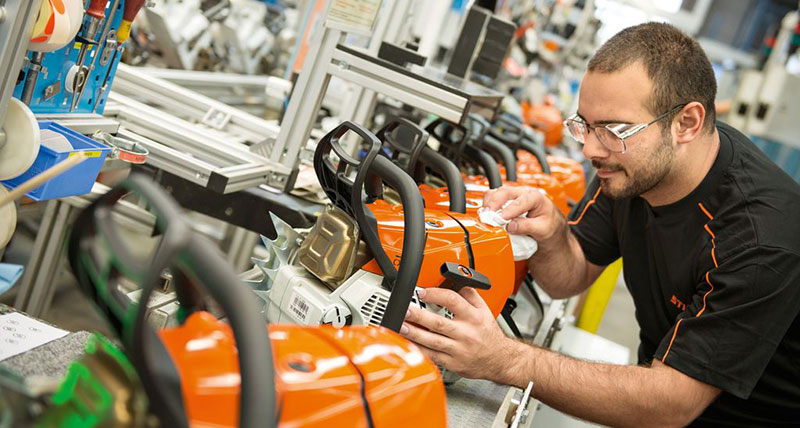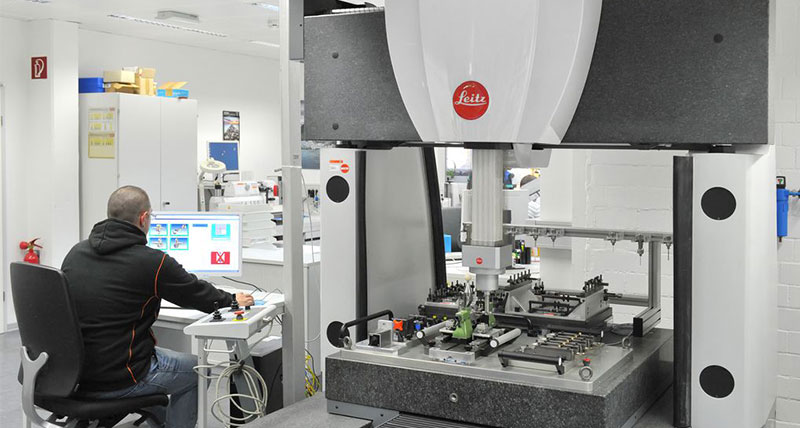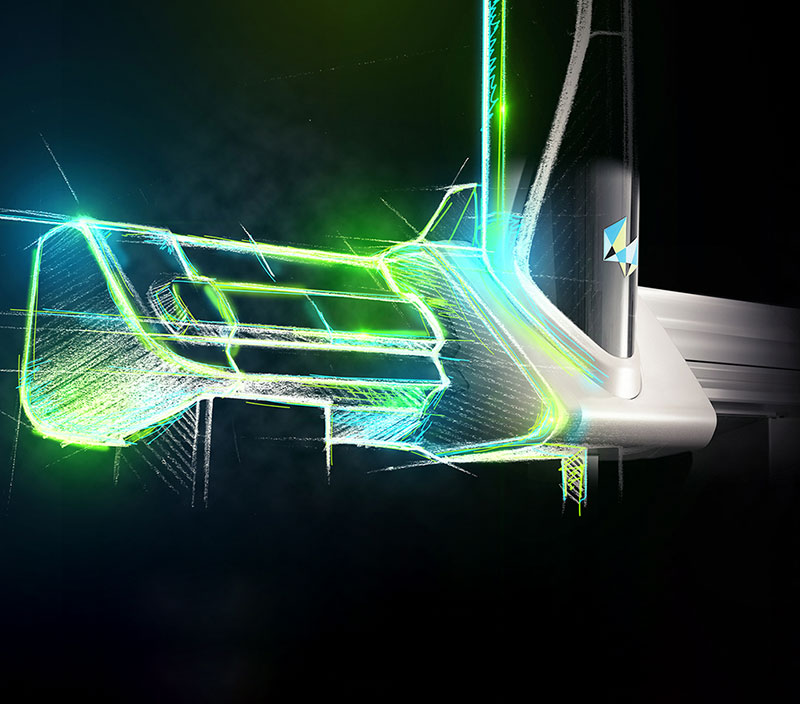Measurement at the cutting edge
Stihl - Germany
Contact us

When it comes to high-precision measurement in a three-shift operation, slow processes and laborious conventional measuring technology can strain patience, effectiveness and efficiency. With a quantum leap in measuring technology, the traditional Swabian company Stihl has now significantly accelerated the quality testing of crankshafts and connecting rods at their main factory in Waiblingen, Germany. They use the Leitz PMM-C 3D coordinate measuring machine (CMM) and highly parameterised software which enables operator self-checking, even with complex measurements.
Whether it’s a workhorse for tree felling, a reliable tool for DIY enthusiasts, a multi-function craft tool used by the army and police, or as a lifesaver for the fire brigade and disaster response teams – Stihl power saws are sought-after around the world. In fact, at times, entire freight planes have had to be chartered to cover the enormous demand of tree fellers in Canada and the USA.
However, the world’s premier chainsaw manufacturer can do a lot more than that. The Stihl Group develops, manufactures and sells a variety of motorised tools for forestry and agriculture, as well as landscaping, the construction trade and private users. Its product range extends from blowers to angle grinders and from augers to cleaning equipment – across more than 10 product groups.
Founded in 1926 and based in Waiblingen-Neustadt, Germany, the family-run Swabian company currently employs around 15,000 people worldwide and exceeded the €3 billion turnover mark in 2015. At the same time, its global investments, totalling €235 million in 2015, set a new record in the company’s history. In good Swabian entrepreneurial spirit, all the investments were funded from the company’s own assets as a matter of principle. They were also subject to thorough consideration regarding economy, effectiveness and future security before a decision was made.
The investment plan included Factory 1 at the company’s main location in Waiblingen, where quality assurance at the Crank Drive Centre crowned Stihl’s successful 2015 with a quantum leap in measuring technology – replacing its previous equipment with an ultra-high accuracy 3D CMM.
The heart of motorised Stihl tools, the crankshaft and connecting rod, are made at the Crank Drive Centre. The perfect running of these parts is the basis for optimum performance and a lack of vibration, as well as the legendary long service life of every Stihl motor.
“What we produce here are central precision parts with the tightest of tolerances, in the micron range,” explained Stefan Baumert, head of crank drive quality planning at Stihl’s Factory 1 in Waiblingen.
Greater work expenditure as a result of multiple tool changes
“We generally carry out testing alongside serial production as well as inspection testing here,” continued the chartered engineer. “This primarily involves shape and position measurement, but also the checking of roundness, parallelism and cylindricity, to name the most important features. A high level of dexterity and patience are required here, and this was exactly the challenge we faced, especially with regard to testing alongside serial production.”
As they are too complex for operator self-checking during production, measurements accompanying serial production – in addition to inspection testing – had to be carried out in the precision measuring room by quality-assurance specialists. Ultimately, it came down to measurement processes requiring a certain degree of experience and user expertise
The entire process had to be refined to be faster, more effective and more economical.
“A host of different measuring machines, such as shape measuring machines, were available to us for this purpose,” said Baumert in recollection of the original equipment. “Multiple systems also means lots of work expenditure, just for the repeated reclamping of the test part for each individual measurement process alone. Greater work expenditure is nothing more than lost time.”
Things got tough when the personnel capacity of the precision measuring room could hardly cover the demand for 24/6 operation. “To eliminate this bottleneck, we had to increasingly call upon employees from the manufacturing department for testing in the precision measuring room,” said Baumert of the situation. Extensive instruction, qualification and then supervision of the manufacturing employees were required for this.
Added to this was the influence of the operator. The machines were highly accurate, but lost some measurement precision on the user side, for example when manually orienting crankshafts while charting line graphs.
The tightest of tolerances, limited time and increased measurement throughput – a trio that challenge even the most experienced quality-assurance officer. “When you then also have to meet the most stringent requirements regarding documentation and reproducibility of the measurement results, you quickly reach the limit of what’s feasible,” said the Crank Drive Centre’s quality planner.
The need for action was therefore clear – especially because it was becoming increasingly difficult to acquire spare parts and software updates for the existing measurement equipment.
“The entire process had to be refined to be faster, more effective and more economical; there needed to be less operator influence in the measurement process and reproducible results need to be obtained,” said Baumert in summary of the specifications for new measuring technology formulated against this backdrop.
Great expectations for accuracy and repeatability
Following extensive market research and a critical selection process, Stihl chose to rely on the solution expertise of Hexagon Manufacturing Intelligence and their ultra-high accuracy coordinate measuring technology.
“It was the specialists at Hexagon who were best and most convincingly able to explain to me how our needs could be met, including when it came to the functional scope of the software. The trust was there straight away,” affirmed Baumert.
“The fact that we are able to fulfil the accuracy specifications of the customer in the micron range using the selected ultra-high accuracy Leitz PMM-C CMM was verified to the customer by running measurement tests on their components together with them at our site in Wetzlar,” explained Gerhard Ehling, regional sales support manager at Hexagon Manufacturing Intelligence and coordinator of the Stihl project. “Just as important was the verification of a corresponding capability analysis for repeatability. With a Cg value of 1.33, we keep Stihl on the very safe side here as well.”
 The Leitz PMM-C is a bridge-type 3D CMM with a fixed bridge. It combines maximum accuracy with exceptional speed, guaranteeing optimum measurement throughput. This enables the machine to quickly and economically manage any complex measuring task, and it can even be used as a gear measurement centre.
The Leitz PMM-C is a bridge-type 3D CMM with a fixed bridge. It combines maximum accuracy with exceptional speed, guaranteeing optimum measurement throughput. This enables the machine to quickly and economically manage any complex measuring task, and it can even be used as a gear measurement centre.
The bridge design featuring a fixed bridge made of cast iron and a granite base guarantees long-term stability, rigidity of the measuring axes and consistent accuracy across the entire measurement volume.
High measuring speed is made possible by the servo drive with its ball screws, which also accelerates very quickly over short distances while maintaining extremely reliable position determination. Decoupled X and Y axes enable fast correction options and quick recommissioning.
Outfitted with a LSP-S2 probe head with integrated high-speed scanning, the Leitz PMM-C is also characterised by its ability to capture large volumes of points. This also makes it suitable for fast shape measurement, just like at Stihl in Waiblingen.
Variable high-speed scanning ensures optimum measuring speed depending on tolerances and geometry characteristics. The probe can quickly cover soft curves and straight lines, although sharp curves and tight tolerances reduce the speed of the system.
Significant time savings during inspection and serial testing
“The time we have saved during inspection testing with the Leitz PMM-C is significant,” said Stihl quality planner Baumert with satisfaction. “With our previous equipment, we needed a good 30 minutes for a complete measurement run of a crankshaft, partially due to frequent reclamping. Today, we can do it in just 7 minutes. Mind you, this is with maximum accuracy and absolute repeatability. That’s downright impressive!”
A significant portion of the time saving was the user-specific user interface based on the QUINDOS measuring software from Hexagon, which was adapted to Stihl’s needs. Baumert confirmed this, “Thanks to clear user guidance and extensive configuration of the measuring programs, our employees also cope with the system with no trouble at all with regard to operator self-checking. They can carry out measurement reliably and precisely after a single training shift.”
“Add to this the fact that operator influence is practically ruled out and that the software provides optimum measurement results almost automatically in combination with the machine,” added Hexagon sales support manager Ehling.
This is also the case when different types of components need to be tested. The configured QUINDOS measuring programs of the individual product families, in combination with a suitable product input mask, ensure that the measurement processes are always the same and that the operator need only enter the specific part data.
Added benefits of testing-equipment calibration
The team at Stihl have also discovered another use for the ultra-high accuracy Leitz PMM-C. Since mid-2016, they have also been using the CMM to calibrate testing equipment such as gauges at the Crank Drive Centre.
Just for this purpose, Stihl created a device with which up to 40 testing units can be clamped and evaluated in a single measurement process. The measuring program, on the other hand, was created by Hexagon. This is an excellent example showing additional areas of use and the great flexibility of the Leitz PMM-C within the framework of this successful project.
Faster, more effective and with greater precision – everything runs smoothly at the quality-assurance department of Stihl’s Crank Drive Centre. Now there’s nothing left to saw away at their time, nerves and efficiency.
